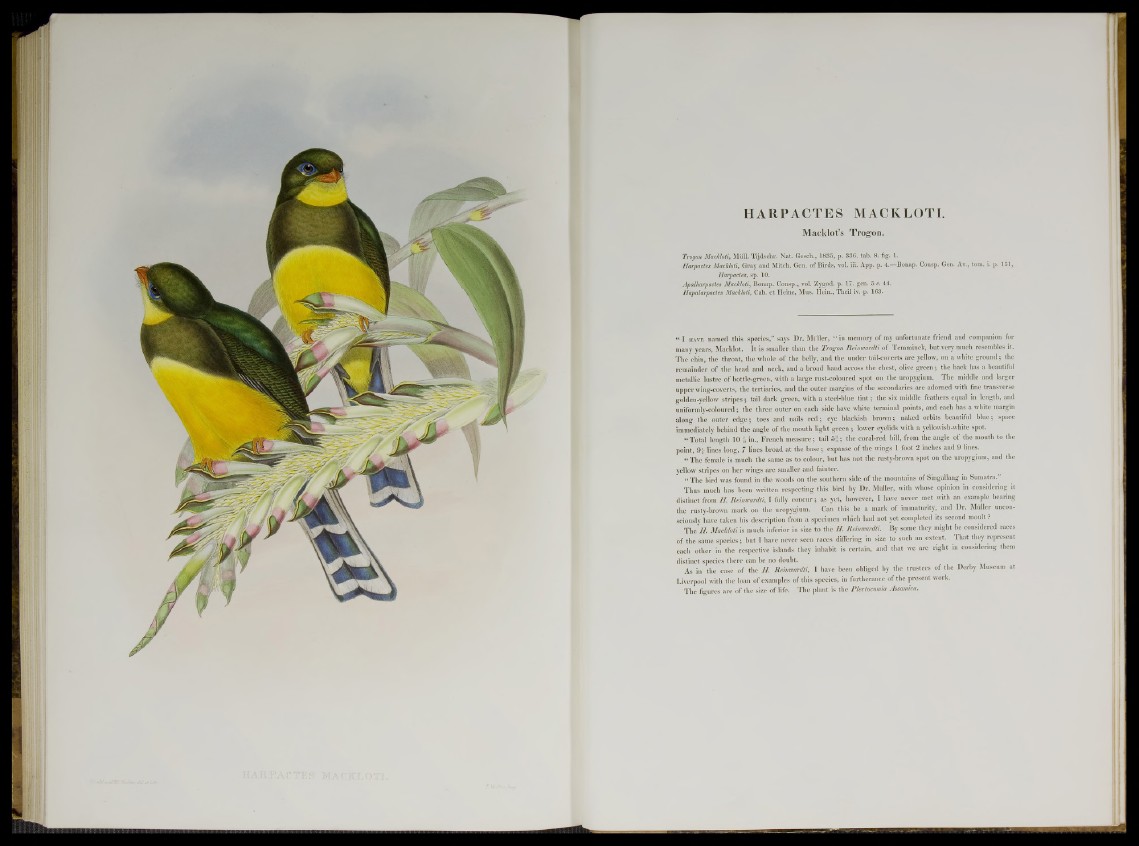
HARPACTES MACKLOTI.
Macklot’s Trogon.
Trogon Mackloti, Müll. Tijdschr. Nat. Gesch., 1835, p. 336. tab. 8. fig. 1.
Harpactes Mackloti, Gray and Mitch. Gen. of Birds, vol. iii. App. p. 4.—Bonap. Consp. Gen. Ay., tom. i. p. 151,
Harpactes, sp. 10.
Apalharpactes Mackloti, Bonap. Consp., vol. Zygod. p. 17. gen. 5 e. 44.
Hapalarpactes Mackloti, Cab. et Heine, Mus. Hein., Theil iv. p. 163.
“ I h a v e named this species,” says Dr. Mi ller, “ in memory of my unfortunate friend and companion for
many years, Macklot. It is smaller than the Trogon Reinwardti of Temminck, but very much resembles it.
The chin, the throat, the whole of the belly, and the under tail-coverts are yellow, on a white ground; the
remainder of the head and neck, and a broad hand across the chest, olive green; the back has a beautiful
metallic lustre of bottle-green, with a large rust-coloured spot on the uropygium. The middle and larger
upper wing-coverts, the tertiaries, and the outer margins of the secondaries are adorned with fine transverse
golden-yellow stripes; tail dark green, with a steel-blue tint; the six middle feathers equal in length, and
uniformly-coloured; the three outer on each side have white terminal points, and each has a white margin
along the outer edge; toes and nails red; eye blackish brown; naked orbits beautiful blue; space
immediately behind the angle of the mouth light green ; lower eyelids with a yellowish-white spot.
“ Total length 10 f, in., French measure; tail 5£; the coral-red bill, from the angle of the mouth to the
point, 94- lines long, 7 lines broad at the base; expause of the wings 1 foot 2 inches and 9 lines.
“ The female is much the same as to colour, but has not the rusty-brown spot on the uropygium, and the
yellow stripes on her wings are smaller and fainter.
“ The bird was found in the woods on the southern side of the mountains of Singallang in Sumatra.
Thus much has been written respecting this bird by Dr. Muller, with whose opinion in considering it
distinct from H Reinwardti, I fully concur; as yet, however, I have never met with an example bearing
the rusty-brown mark on the uropygium. Can this be a mark of immaturity, and Dr. Muller unconsciously
have taken his description from a specimen which had not yet completed its second moult ?
The H. Mackloti is much inferior in size to the H. Reinwardti. By some they might be considered races
of the same species; hut I have never seen races differing in size to such an extent. That they represent
each other in the respective islands they inhabit is certain, and that we are right in considering them
distinct species there can be no doubt.
As in the case of the H. Beimardti, I have been obliged by the trustees of the Derby Museum at
Liverpool with the loan of examples of this species, in furtherance of the present work.
The figures are of the size of life. The plant is the Plecti/comia Assamica.